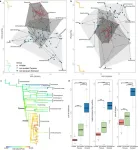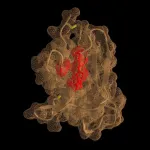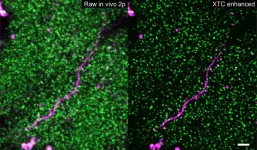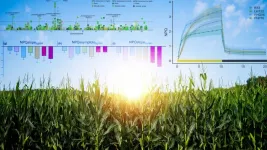(Press-News.org)
New research has revealed being active could lower the risk of type 2 diabetes, even in people with a high genetic risk of developing the medical condition.
The University of Sydney-led study found higher levels of total physical activity, especially moderate- to vigorous-intensity physical activity, had a strong association with a lower risk of developing type 2 diabetes.
The findings were published in the British Journal of Sports Medicine.
The researchers say the study demonstrates higher levels of physical activity should be promoted as a major strategy for type 2 diabetes prevention, which affects millions of Australians.
The study involved 59,325 adults from the UK Biobank, who wore accelerometers (activity trackers worn on their wrist) at the start of the study and were then followed for up to seven years to track health outcomes.
The UK Biobank is a large-scale biomedical database and research resource containing anonymised genetic, lifestyle and health information from half a million UK participants.
This included genetic markers associated with a higher risk of developing type 2 diabetes. People with a high genetic risk score had 2.4 times the risk of developing type 2 diabetes when compared with those with a low genetic risk score.
The study showed more than an hour of moderate- to vigorous-intensity physical activity per day was associated with a 74 percent lower risk of developing type 2 diabetes when compared with participants who did less than 5 minutes of physical activity,
This was even when other factors, including genetic risk, were accounted for.
Another compelling finding was that participants with a high genetic risk, but who were in the most physically active category, actually had a lower risk of developing type 2 diabetes when compared with those with a low genetic risk but in the least active category.
Senior author Associate Professor Melody Ding from the Charles Perkins Centre and the Faculty of Medicine and Health says although the role of genetics and physical activity in the onset of type 2 diabetes is well established, until now most data was self-reported and there was little evidence whether the genetic risk could be counteracted by physical activity.
“We are unable to control our genetic risk and family history, but this finding provides promising and positive news that through an active lifestyle, one can ‘fight off’ much of the excessive risk for type 2 diabetes.”
Associate Professor Ding says moderate-intensity physical activity describes movements that get you sweating and slightly out of breath, such as brisk walking and general gardening.
Examples of vigorous-intensity physical activity include running, aerobic dancing, cycling uphill or at a fast pace and heavy gardening such as digging – all activities that make you out of breath or cause you to breathe heavily.
Study to help inform public health guidelines
Diabetes is a global public health concern. In 2021, there were 537 million adults living with diabetes worldwide. Almost 1.2 million Australians were recorded as living with type 2 diabetes in 2020.
The findings also hold a strong personal meaning for Associate Professor Ding, whose father was recently diagnosed with type 2 diabetes in his sixties.
“My dad’s side of the family has a history of type 2 diabetes, so the result of the study is extremely heartening for my family and myself. As an already active person, I now have extra motivation to keep this active lifestyle,” says Associate Professor Ding.
“Our hope is that this study will inform public health and clinical guidelines so that it can help chronic disease prevention for health professionals, organisations and the public.”
“I am so delighted to share our research results with a broad audience to let people know that physical activity is health-enhancing, especially for people with high genetic risk. If you have a family history of type 2 diabetes, or even if you don’t, today is the day to start being physically active,” says PhD candidate Mengyun (Susan) Luo, who led the study.
-ENDS-
Declaration: The authors declare no conflicts of interest. Associate Professor Melody Ding is supported by a National Health and Medical Research Council Investigator Grant. The funders and sponsors played no role in the study design; in the collection, analysis, and interpretation of data; in the writing of the report; and in the decision to submit the article for publication.
END
Researchers who lead the world’s first comprehensive sequencing program for newborn infants have published the next chapter in the ongoing study of the BabySeq Project, with new findings on infants and families who have been followed for 3-5 years. In a study published today in the American Journal of Human Genetics, researchers from Mass General Brigham and Boston Children’s Hospital reported that over 10 percent of the first 159 infants to undergo screening through DNA sequencing were discovered ...
DURHAM, N.C. – Tirzepatide, a drug approved for diabetes and on the fast track for approval as a weight loss therapy, works through a unique ability to activate two different mechanisms the body uses to control insulin secretion and energy balance, Duke Health researchers report.
The finding, reported June 5 in the journal Nature Metabolism, is the first study to use cells from human donors to demonstrate how tirzepatide stimulates insulin secretion, an important action utilized by this drug to lower blood glucose in patients with type 2 diabetes.
“Understanding the potential of drugs ...
CHICAGO – Patients with early relapsed or refractory large B-cell lymphoma had significantly improved overall survival when treated with the chimeric antigen receptor (CAR) T cell therapy axicabtagene ciloleucel (axi-cel) when compared to the current standard-of-care chemoimmunotherapy, according to results of the Phase III ZUMA-7 trial reported by researchers from The University of Texas MD Anderson Cancer Center.
Data from the study were presented today by Jason Westin, M.D., director of clinical research in the Department of Lymphoma and Myeloma, at the 2023 American Society of Clinical Oncology (ASCO) Annual Meeting and published concurrently in ...
Women have long searched for remedies for the bothersome hot flashes that often come with menopause.
In a novel investigation, researchers at UC San Francisco tested the benefits of continuously wearing a nitroglycerin patch – an established treatment for chest pain from coronary artery disease – for menopausal women experiencing at least seven hot flashes a day. Unlike most treatments for hot flashes that target brain mechanisms, nitroglycerin works on blood vessels throughout the body.
The results were mixed. While ...
The assembly of the volant bird body plan from the ancestral bulky dinosaurian condition is an enduring topic of evolutionary biology. The body plan of volant birds demonstrates a pronounced decrease in body size and proportionate elongation of the forelimbs. Given the scaling relationship between limb and body size, changes to the former were likely clouded by changes to the entire body size.
Since changes to individual limb elements provides the direct basis for natural selection, they are essential to comprehending branch- and lineage-specific evolutionary patterns across the transition from terrestrial to ...
How do today’s indigenous communities of South America trace back to the history of human migration and contact in the continent? An international team has worked to reconstruct the legacy of Chile’s largest indigenous community, the Mapuche, in a quest to strengthen their representation in the history of the continent. It appears the Mapuche long lived in relative isolation but do bear some influences from other populations of the Central Andes and the far south of Chile.
South America was the last continent ...
LA JOLLA, CALIF. – June 5, 2023 – Researchers at Sanford Burnham Prebys, collaborating with scientists from Eli Lilly and Company, have revealed the structure and function of a drug called LY3361237, which can reduce the harmful activity of the immune system to help treat autoimmune diseases. Their work laid the foundation for a new treatment that’s currently in a Phase 2 clinical trial for lupus, an autoimmune disease affecting multiple organs in the body. The study is published in Structure, a Cell Press journal.
The ...
FOR IMMEDIATE RELEASE
Johns Hopkins scientists have developed a method involving artificial intelligence to visualize and track changes in the strength of synapses — the connection points through which nerve cells in the brain communicate — in live animals. The technique, described in Nature Methods, should lead, the scientists say, to a better understanding of how such connections in human brains change with learning, aging, injury and disease.
“If you want to learn more about how an orchestra plays, you have to watch individual players over time, and this ...
Two new discoveries from the Dudley lab at UVA Cancer Center highlight the different roles of blood vessels in solid tumors – and the findings could help prevent breast cancer from spreading and enhance the effectiveness of one of the most important new cancer treatments in many years.
In one new scientific paper, researcher Andrew C. Dudley, PhD, and his team report that the effectiveness of immunotherapy drugs called immune check blockade is enhanced when blood vessels are targeted in a specific way. (Immunotherapy enhances the power of the immune system to fight cancer and other diseases.) In another paper, published ...
Awash in a rowed sea of its brethren, a corn leaf relegated to the lowest rung of its stem spends much of a June afternoon doused in shade cast by the higher-ups.
Then a gust begins pushing, pulling and twisting the waxy wings in concert, cracking a window to the fireball roiling 93 million miles away. It’s a prime, precious opportunity for photosynthesis to transform the sunlight into food. Unfortunately, the photosynthetic equivalent of a surge protector — one evolved to help plants mitigate damage driven by sudden spikes of high-intensity light — is slow to reset after so much time in the shade. The gust dissipates, the moment ...





